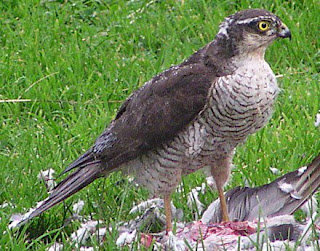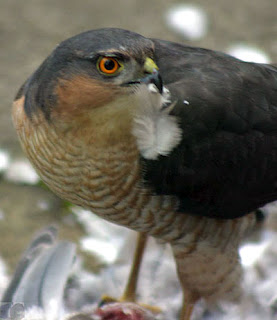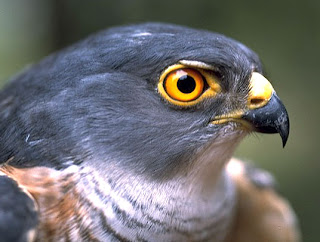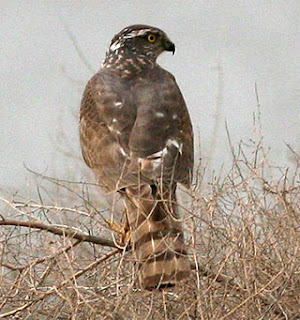Characteristics
Adult males have a slate grey back and white under-parts, closely barred with orange. Their grey tail has 4-5 dark bars. Females are larger, with brown upper parts, a white stripe over the eye and dark barring underneath. They look heavier than the males. Habitat
Habitat
The Sparrow hawk can be found in woodlands, along hedgerows and in parks and gardens. The Sparrow hawk builds its nest in a tree. The nest is a quite flat platform made from twigs. The eggs are about 40 mm by 32 mm, smooth and non-glossy, bluish-white with dark brown markings. Incubation is by the female only. Both adults feed the young birds, though the newly-hatched are usually fed by the female with the male hunting and bringing the food to the nest.
 Behaviour
Behaviour
Sparrow hawks are usually seen flying fast and low in pursuit of prey. Their broad, rounded wings and long tail are adapted for flying between trunks and branches enabling them to weave in and out of trees at high speed. In flight, they tend to soar between powerful bursts of several wing beats and have a characteristic flap-flap-glide motion. They never hover and are remarkably agile even at speed.
 Their diet is predominantly small birds; the size difference between sexes means that the female often preys on larger birds, like thrushes and starlings and occasionally pigeons, while the male preys on smaller birds like tits, finches and sparrows. Small mammals, nestlings and carrion are also taken.
Their diet is predominantly small birds; the size difference between sexes means that the female often preys on larger birds, like thrushes and starlings and occasionally pigeons, while the male preys on smaller birds like tits, finches and sparrows. Small mammals, nestlings and carrion are also taken.
 The Sparrow hawk’s hunting technique relies on stealth; it usually watches from a perch among cover for prey, then flies fast and low, so that it can then seize its intended prey with complete surprise. If it misses, lengthy chases can ensue even among trees and undergrowth.
The Sparrow hawk’s hunting technique relies on stealth; it usually watches from a perch among cover for prey, then flies fast and low, so that it can then seize its intended prey with complete surprise. If it misses, lengthy chases can ensue even among trees and undergrowth.
B.A.B.










